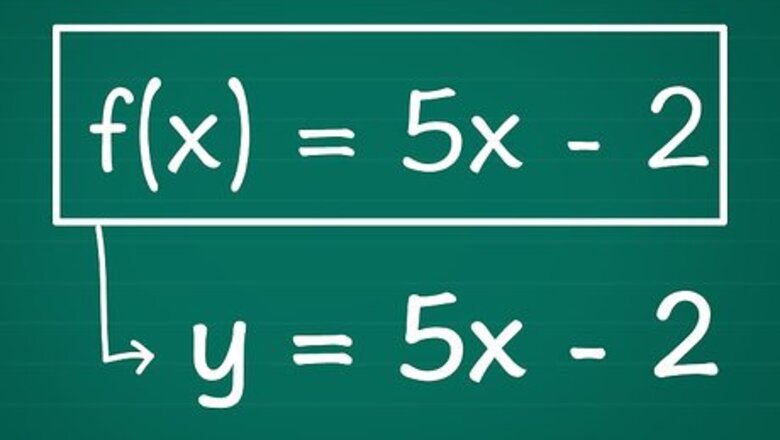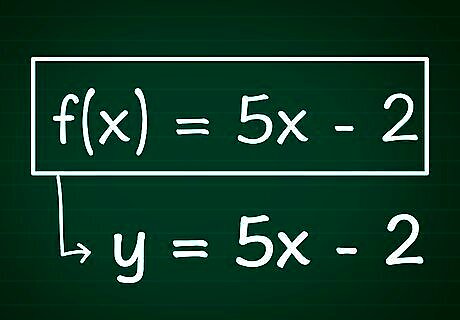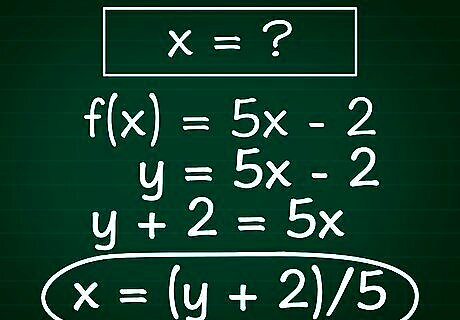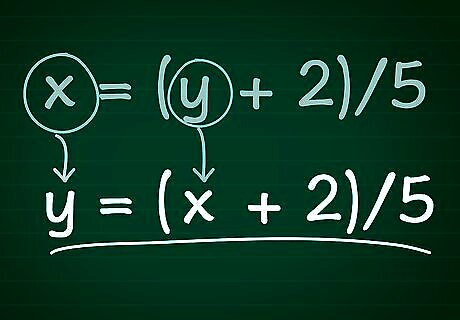
views
X
Research source
Finding the inverse of a function may sound like a complex process, but for simple equations, all that's required is knowledge of basic algebraic operations. Read on for step-by-step instructions and an illustrative example.

Write your function, replacing f(x) with y if necessary. Your formula should have y on one side of the equals sign by itself with the x terms on the other side of the equals sign. If you have an equation that's already written in terms of y and x (for instance, 2 + y = 3x), all you need to do is solve for y by isolating it on one side of the equals sign. Example: If we have a function f(x) = 5x - 2, we would rewrite it as y = 5x - 2 simply by replacing the "f(x)" with a y. Note: f(x) is the standard function notation, but if you're dealing with multiple functions, each one gets a different letter to make telling them apart easier. For example, g(x) and h(x) are each common identifiers for functions.

Solve for x. In other words, perform the necessary mathematical operations to isolate x by itself on one side of the equal sign. Basic algebraic principles will guide you here: if x has a numeric coefficient, divide both sides of the equation by this number; if a certain number is added to the x term(s) on one side of the equals sign, subtract this number from both sides, and so on. Remember, you can perform any operation on one side of the equation as long as you perform the operation on every term on both sides of the equal sign. Example: To continue our example, first, we'd add 2 to both sides of the equation. This gives us y + 2 = 5x. We'd then divide both sides of the equation by 5, yielding (y + 2)/5 = x. Finally, to make it easier to read, we'll rewrite the equation with "x" on the left side: x = (y + 2)/5.

Switch the variables. Replace x with y and vice versa. The resulting equation is the inverse of the original function. In other words, if we substitute a value for x into our original equation and get an answer, when we substitute that answer into the inverse equation (again for x), we'll get our original value back! Example: After switching x and y, we'd have y = (x + 2)/5

Replace y with "f(x)." Inverse functions are usually written as f(x) = (x terms) . Note that in this case, the -1 exponent doesn't mean we should perform an exponent operation on our function. It's just a way of indicating that this function is the inverse of our original. Since taking x to the -1st power gives the fraction 1/x, you can also think of f(x) as a way of writing "1/f(x)," which also signifies the inverse of f(x).

Check your work. Try substituting a constant into the original function for x. If you found the correct inverse, you should be able to plug the result into the inverse function and get your original x-value as the result. Example: Let's substitute 4 for x in our original equation. This gives us f(x) = 5(4) - 2, or f(x) = 18. Next, let's substitute our answer, 18, into our inverse function for x. If we do this, we get y = (18 + 2)/5, which simplifies to y = 20/5, which further simplifies to y = 4. 4 is our original x-value, so we know we've calculated the correct inverse function.


















Comments
0 comment